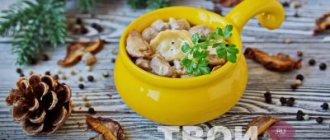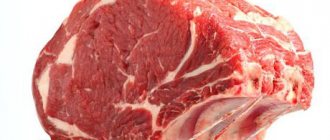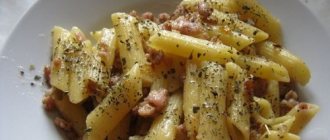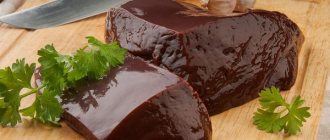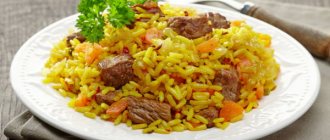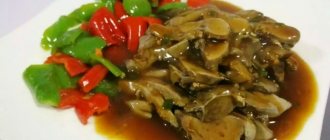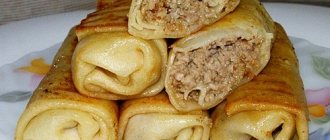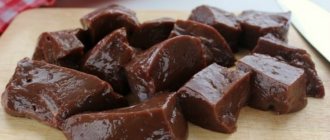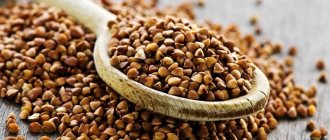Popular now:
Chicken saladSimple, easy, quick saladsCrab saladCabbage saladCucumber saladClassic saladsCaesar saladCrab stick saladsEgg saladCheese saladBean saladGreek saladCarrot saladsCorn saladVinegretteMimosa saladTomato saladPineapple saladMushroom saladCale salad MarovLiver saladsBirthday saladsBirthday cakesCake for girlsMastic cakeHoney CakeEaster Easter cakesEaster recipesCottage cheese EasterBirthday PiesHomemade cookiesPancakes and pancakesPiesBunsCheese cakesFrostersCupcakes, muffins, cupcakesCharlotteCakeDonutsMannik - semolina piePancakes and pancakes with milkFlatcakesKefir pancakesKhachapuriCheesecakesDranikiK apcakesPies in the ovenCheesecakeCharlotte with applesMuffinsMeringue and meringuesKefir pieIn the ovenFreezingPotatoes in the ovenIn a slow cookerChicken in the ovenMeat in the ovenStuffed dishesPork in the ovenIn a bread machineFish in the ovenPorridge in a slow cookerKebabsPork kebabsPorridgeCutletsCasserolesPilaf kiCurd casseroleStuffed cabbage dumplingsDumplingsMeatballsPorridge on milkPizzaGoulashChebureki with and without meatIn batterChopsLasagnaLagmanChicken cutletsFrench meat in the ovenStewed cabbageSemolina porridgeRice porridgeMillet porridgeCurd casserole in the ovenKhinkaliLazy cabbage rollsChicken in sauceIcing for cake and bakingCream for cake and bakingFor boiled cream Gravy Creamy sauce Sauce for chicken Potatoes with meat Chicken with potatoes Jam for the winter Homemade jam Diet recipes for weight loss Dietary recipes See the entire catalog Hearty stewed cabbage with pork and potatoes. I love stewed cabbage. I cook it in a variety of variations: with soy sauce, with raisins, with apples, with sausages, with sausage. But the most satisfying dish is obtained by adding potatoes and meat. In my recipe it is pork (fried), but you can use any meat. It will be equally delicious with chicken and beef.
- Prepare the ingredients. Cut the meat into small pieces.
- Peel the carrots and cut into small cubes.
- Shred the cabbage.
- Fry the carrots in vegetable oil for about 2 minutes.
- Place the meat in the pan with the carrots. Fry, stirring, for about 10 minutes.
- Salt and pepper. Pour in 100 ml of water and simmer covered for about 20 minutes.
- Cut the potatoes into cubes.
- Add cabbage and potatoes to the pan. Salt and pepper. Mix.
Simmer for about 5 more minutes. Pour in 200 ml of water, cover the pan with a lid and simmer for about 15 minutes until the vegetables are ready.
- Add tomatoes in their own juice. Simmer for another 5-7 minutes.
- Chop the greens.
- Sprinkle the cabbage with chopped herbs, stir and remove from heat. Tomatoes in their own juice can be replaced with fresh tomatoes, ketchup or tomato paste.
To prevent the formation of smoke during frying...
To prevent the formation of smoke while frying vegetables, meat or fish, do not add cold vegetable oil to the frying pan. Mixing with hot water, it creates fumes.
Preventing cabbage odor.
As you know, white cabbage emits a very unpleasant odor around itself during cooking. To prevent the appearance of this smell, you need to put the sky in the pan with boiling cabbage.
To keep the beef juicy...
If you want to get a juicy piece of roast beef, you first need to fry a whole piece of beef in a small amount of oil or fat so that a crust appears on its entire surface. After the beef you can….
How to get very tender beef?
If large pieces of beef are first fried in a frying pan in a small amount of oil so that a golden brown crust forms on the entire surface, and then baked in the oven, the beef will be...
How to bread potato balls?
To make the mashed potato balls as tasty and beautiful as possible, they must first be breaded in beaten egg white. And then roll in rice flour.
To keep the goulash soft
To make the goulash soft and tender, it must be simmered over low heat for a long time (about 2 hours). The dish should be salted half an hour before it is ready. This will help make the meat n….
How long does it take to stew cabbage rolls?
In order for the cabbage rolls to turn out tasty and juicy, they should be stewed for from half an hour to 2 hours. The time spent depends on the desired result - if you want dense cabbage rolls with crispy cabbage, then...
- Jacket potatoes - 74 kcal/100g
- Fried potatoes - 192 kcal/100g
- Ripe potatoes – 80 kcal/100g
- Boiled potatoes - 82 kcal/100g
- Baked potatoes – 70 kcal/100g
- Mashed potatoes – 380 kcal/100g
- Green cabbage – 46 kcal/100g
- Fresh frozen green cabbage in packaging – 45 kcal/100g
- Boar ham – 113 kcal/100g
- Pork – lean roast – 184 kcal/100g
- Pork - chop on the bone - 537 kcal/100g
- Pork – shoulder – 593 kcal/100g
- Pork - schnitzel - 352 kcal/100g
- Fatty pork – 333 kcal/100g
- Pork meat – 357 kcal/100g
- Carrots – 33 kcal/100g
- Boiled carrots – 25 kcal/100g
- Dried carrots – 275 kcal/100g
- Ground black pepper – 255 kcal/100g
- Vegetable oil – 873 kcal/100g
- Tomato paste – 28 kcal/100g
- Salt – 0 kcal/100g
- Water - kcal/100g
Calorie content of foods: Cabbage, Pork, Water, Tomato paste, Potatoes, Carrots, Vegetable oil, Ground black pepper, Salt
Popular now:
Chicken saladSimple, easy, quick saladsCrab saladCabbage saladCucumber saladClassic saladsCaesar saladCrab stick saladsEgg saladCheese saladBean saladGreek saladCarrot saladsCorn saladVinegretteMimosa saladTomato saladPineapple saladMushroom saladCale salad MarovLiver saladsBirthday saladsBirthday cakesCake for girlsMastic cakeHoney CakeEaster Easter cakesEaster recipesCottage cheese EasterBirthday PiesHomemade cookiesPancakes and pancakesPiesBunsCheese cakesFrostersCupcakes, muffins, cupcakesCharlotteCakeDonutsMannik - semolina piePancakes and pancakes with milkFlatcakesKefir pancakesKhachapuriCheesecakesDranikiK apcakesPies in the ovenCheesecakeCharlotte with applesMuffinsMeringue and meringuesKefir pieIn the ovenFreezingPotatoes in the ovenIn a slow cookerChicken in the ovenMeat in the ovenStuffed dishesPork in the ovenIn a bread machineFish in the ovenPorridge in a slow cookerKebabsPork kebabsPorridgeCutletsCasserolesPilaf kiCurd casseroleStuffed cabbage dumplingsDumplingsMeatballsPorridge on milkPizzaGoulashChebureki with and without meatIn batterChopsLasagnaLagmanChicken cutletsFrench meat in the ovenStewed cabbageSemolina porridgeRice porridgeMillet porridgeCurd casserole in the ovenKhinkaliLazy cabbage rollsChicken in sauceIcing for cake and bakingCream for cake and bakingFor boiled cream Gravy Cream sauce Sauce for chicken Potatoes with meat Chicken with potatoes Jam for the winter Homemade jam Diet recipes for weight loss Diet recipes See the entire catalog This is aromatic and tasty You will definitely like the recipe! delicious stewed potatoes Crumbly, sweet potatoes love to be flavored with fat - vegetable or animal. I will share with you my method of preparing stewed potatoes with meat.
- Ingredients.
- The pork needs to be cut into large pieces 3*3cm, and then fried in vegetable oil in a deep frying pan, stirring until the meat is browned.
- Add coarsely chopped carrots to the meat.
- and chopped onions.
- Now pour water over the meat and vegetables so that the meat is covered and simmer over low heat for about an hour. Check the meat as it cooks; it may be cooked earlier, especially if the pork is fresh. As soon as the meat is almost cooked, salt and pepper the dish and season with spices. And add chopped potatoes and bell peppers.
- Add water again and simmer until the potatoes are ready. You can transfer the stew and potatoes into a cauldron and simmer in the oven for 15-20 minutes. Or you can finish cooking it in a frying pan with a lid.
To prevent the formation of smoke during frying...
To prevent the formation of smoke while frying vegetables, meat or fish, do not add cold vegetable oil to the frying pan. Mixing with hot water, it creates fumes.
To keep the goulash soft
To make the goulash soft and tender, it must be simmered over low heat for a long time (about 2 hours). The dish should be salted half an hour before it is ready. This will help make the meat n….
To keep the beef juicy...
If you want to get a juicy piece of roast beef, you first need to fry a whole piece of beef in a small amount of oil or fat so that a crust appears on its entire surface. After the beef you can….
How to get very tender beef?
If large pieces of beef are first fried in a frying pan in a small amount of oil so that a golden brown crust forms on the entire surface, and then baked in the oven, the beef will be...
How to bread potato balls?
To make the mashed potato balls as tasty and beautiful as possible, they must first be breaded in beaten egg white. And then roll in rice flour.
How to make a golden crust
To get a golden crust on steak or chicken, take sugar and grind it in a coffee grinder until it becomes powdery. Heat the frying pan on the stove, but do not rush to add oil. Sprinkle with a small amount...
How to fry a steak in a frying pan
Start frying the steak only when the fat or vegetable oil in the pan is already very hot. You don't need a lot of fat, this is an important point. The meat must be held until it forms...
- Onion – 41 kcal/100g
- Jacket potatoes - 74 kcal/100g
- Fried potatoes - 192 kcal/100g
- Ripe potatoes – 80 kcal/100g
- Boiled potatoes - 82 kcal/100g
- Baked potatoes – 70 kcal/100g
- Mashed potatoes – 380 kcal/100g
- Boar ham – 113 kcal/100g
- Pork – lean roast – 184 kcal/100g
- Pork - chop on the bone - 537 kcal/100g
- Pork – shoulder – 593 kcal/100g
- Pork - schnitzel - 352 kcal/100g
- Fatty pork – 333 kcal/100g
- Pork meat – 357 kcal/100g
- Sweet pepper – 27 kcal/100g
- Carrots – 33 kcal/100g
- Boiled carrots – 25 kcal/100g
- Dried carrots – 275 kcal/100g
- Bay leaf - 313 kcal/100g
- Vegetable oil – 873 kcal/100g
- Black peppercorns – 255 kcal/100g
- Salt – 0 kcal/100g
Calorie content of foods: Potatoes, Pork, Carrots, Onions, Bell peppers, Peppercorns, Bay leaves, Vegetable oil, Salt
Cabbage is an agricultural plant. The leaves form a head around the stem. They are petiolate, large, fleshy, lyre-shaped and pinnately dissected.
The leaves are collected in a basal rosette, which fit tightly to each other. Cabbage flowers are large, collected in clusters, white or yellow. The pods are also large and rejected.
The seeds are large, dark brown, spherical. Cabbage has valuable nutritional qualities. It is used in cooking for preparing various dishes: soups, side dishes, salads, pie fillings, casseroles.
Recipe Stewed potatoes with meat. Calorie, chemical composition and nutritional value.
Stewed potatoes with meat
are rich in vitamins and minerals such as: vitamin A - 28.8%, beta-carotene - 31.1%, vitamin B6 - 12.9%, vitamin B12 - 25.4%, vitamin PP - 18, 1%, potassium - 21.3%, silicon - 105.3%, phosphorus - 13.8%, cobalt - 66.3%, copper - 17.2%, molybdenum - 16.1%, chromium - 18.4 %, zinc - 11.4%
- Vitamin A
is responsible for normal development, reproductive function, skin and eye health, and maintaining immunity. - B-carotene
is provitamin A and has antioxidant properties. 6 mcg of beta carotene is equivalent to 1 mcg of vitamin A. - Vitamin B6
is involved in maintaining the immune response, processes of inhibition and excitation in the central nervous system, in the transformation of amino acids, the metabolism of tryptophan, lipids and nucleic acids, promotes the normal formation of red blood cells, and maintaining normal levels of homocysteine in the blood. Insufficient intake of vitamin B6 is accompanied by decreased appetite, impaired skin condition, and the development of homocysteinemia and anemia. - Vitamin B12
plays an important role in the metabolism and transformation of amino acids. Folate and vitamin B12 are interconnected vitamins that are involved in hematopoiesis. A lack of vitamin B12 leads to the development of partial or secondary folate deficiency, as well as anemia, leukopenia, and thrombocytopenia. - Vitamin PP
is involved in redox reactions of energy metabolism. Insufficient vitamin intake is accompanied by disruption of the normal condition of the skin, gastrointestinal tract and nervous system. - Potassium
is the main intracellular ion that takes part in the regulation of water, acid and electrolyte balance, and is involved in the processes of conducting nerve impulses and regulating blood pressure. - Silicon
is included as a structural component in glycosaminoglycans and stimulates collagen synthesis. - Phosphorus
takes part in many physiological processes, including energy metabolism, regulates acid-base balance, is part of phospholipids, nucleotides and nucleic acids, and is necessary for the mineralization of bones and teeth. Deficiency leads to anorexia, anemia, and rickets. - Cobalt
is part of vitamin B12. Activates enzymes of fatty acid metabolism and folic acid metabolism. - Copper
is part of enzymes that have redox activity and are involved in the metabolism of iron, stimulates the absorption of proteins and carbohydrates. Participates in the processes of providing oxygen to the tissues of the human body. Deficiency is manifested by disturbances in the formation of the cardiovascular system and skeleton, and the development of connective tissue dysplasia. - Molybdenum
is a cofactor for many enzymes that ensure the metabolism of sulfur-containing amino acids, purines and pyrimidines. - Chromium
is involved in the regulation of blood glucose levels, enhancing the effect of insulin. Deficiency leads to decreased glucose tolerance. - Zinc
is part of more than 300 enzymes and is involved in the processes of synthesis and breakdown of carbohydrates, proteins, fats, nucleic acids and in the regulation of the expression of a number of genes. Insufficient consumption leads to anemia, secondary immunodeficiency, liver cirrhosis, sexual dysfunction, and the presence of fetal malformations. Research in recent years has revealed the ability of high doses of zinc to disrupt the absorption of copper and thereby contribute to the development of anemia.
morehide
You can view a complete directory of the healthiest foods in the “My Healthy Diet” app.
Main conclusions
Potatoes are a controversial product. Despite its glycemic index, it can be used both during the diet and for emergency weight loss:
- In a dietary diet, only young vegetables are used for cooking.
- You should not combine potatoes with animal fats and proteins, heavy sauces and large amounts of vegetable oil.
- The healthiest potato is baked. It retains most nutrients while being low in calories.
- To achieve better results, the potato diet must be combined with physical exercise. In this case, starchy substances are converted into energy, and not into subcutaneous fat.
- Fried dishes from this vegetable are unacceptable on any diet.
Whether potatoes become a friend or an enemy of a figure depends only on the method of its preparation. Proper use of this vegetable will help achieve excellent results without radical deprivation.
calories in boiled potatoes - weight loss resources
If you liked this article, try our newsletter. It's free .
Get the latest information on what works for weight loss delivered straight to your inbox. We do not share your email address. Privacy Policy
Sponsored
The tools and information on the Weight Loss Resources website are intended to help you lose weight and maintain weight and do not provide medical advice. If you have, or think you may have, a medical condition, you should consult your doctor before starting a weight loss regimen and/or physical exercise. If you decide to start exercising after a period of relative inactivity, you should start very slowly and consult your doctor if you experience discomfort, stress or any other symptoms. If you experience discomfort or pain during exercise, do not continue. The tools and information on the Weight Loss Resources website are not intended for pregnant or breastfeeding women or persons under 18 years of age. Copyright © 2000-2020 Weight Loss Resources Ltd. All product names, trademarks, registered trademarks, service marks or registered service marks mentioned in any part of the Weight Loss Resources website are the property of their respective owners.
.
Recipe
It would seem that every housewife knows the recipe for stewed beef with potatoes, but only a few have prepared Kalops from Scandinavian cuisine. Be sure to try this simple but very tasty dish!
| Products | Weight (g) | Kcal | B(g) | F (g) | U(g) |
| Water | 500 | — | — | — | — |
| Carrot | 200 | 70 | 3 | 0 | 14 |
| Beef brisket pulp | 500 | 1123 | 85 | 87 | — |
| Bulb onions | 150 | 62 | 2 | 0 | 12 |
| Potato | 300 | 231 | 6 | 1 | 49 |
| Total: | 1650 | 1486 | 96 | 89 | 75 |
| Taking into account boiling: | 1600 | 1486 | 96 | 89 | 75 |
| For 1 serving: | 267 | 248 | 16 | 14.8 | 12.5 |
| Per 100 grams: | 93 | 6.0 | 5.5 | 4.7 | |
| BJU: | 26% | 54% | 20% |
Stew the beef along with onions and carrots, add water periodically. Then add potatoes and simmer until done
No comments
To comment, please log in..
DAILY-MENU
- Recipes
- Special projects
- Participants
- about the project
- Contacts
- Blogs
School of Nutrition
- Editorial column
- How to eat right
- Psychology of eating behavior
- Nutrition and health experts
- Contract offer
- Privacy Policy
Tell your friends
Calorie control
Subscribe to the Calorie Counted Recipes newsletter and not a single extra calorie will be deposited on your waistline
By clicking on the “Subscribe” button you agree to the privacy policy
Cooking stewed potatoes with meat
Potatoes stewed with meat are a favorite dish of many people. After all, such a dinner is not only very tasty, but also quite filling. It is also worth noting that preparing vegetables with meat products does not take much time from the housewife.
How to cook stewed potatoes with meat on the stove
Required Products:
- Pork pulp with a small amount of fat - 250 g;
- young potatoes - 6-7 medium tubers;
- vegetable oil - 12-15 ml;
- large fresh carrots - 2 pcs.;
- spicy tomato sauce - 5 large spoons;
- Large bulbs - 2 pcs.;
- drinking water - a couple of glasses;
- Fresh greens - optional;
- Iodized salt - dessert spoon.
Pork processing process
To make potatoes stewed with meat satisfying and tasty, it is recommended to buy boneless pork meat with reduced fat content. The product should be washed, freed from inedible elements, and then cut into cubes measuring 3 by 3 centimeters.
Vegetable processing process
Stewed potatoes with meat, a photo of which can be seen in this article, involves the use of not only fresh tubers of the above vegetable, but also products such as onions and carrots. Thus, all the necessary ingredients should be washed, peeled and cut into medium cubes. It is recommended to place the potatoes in a bowl of cold water, otherwise they will turn black. The rest of the products can be safely used for heat treatment.
Roasting meat products and vegetables
Before preparing potatoes stewed with meat, pork should be fried with carrots and onions. They need to be placed in a thick-walled pan with butter, salt and pepper, and then placed over medium heat. Once the meat and vegetables are covered with a tea-colored crust, you can easily begin stewing the main ingredient.
Stewing the whole dish
It is necessary to pour pre-diced potatoes into lightly fried pork, carrots and onions. Next, it is recommended to add additional salt to the ingredients with iodized salt, and if desired, add ground pepper. Then add 2-3 glasses of regular drinking water to the potatoes and meat and add thick and spicy tomato paste (4-5 large spoons). After this, you need to turn on the heat to maximum, wait for the broth to boil, reduce the gas, close the pan with a lid and leave to simmer for 40-46 minutes. During this time, the water will partially evaporate and the potatoes will become soft.
Proper serving to the table
Potatoes stewed with meat are recommended to be served hot. For greater aroma and taste, you can additionally add chopped sprigs of fresh herbs, as well as finely chopped cloves of garlic. In addition, the dish will become more high-calorie and richer if it is seasoned with a small amount of liquid sour cream.
As a result of all the above steps, you should definitely get tasty, satisfying and aromatic potatoes with fried pork.
.
Unloading and nutrition for emergency weight loss
Potatoes can also be used during fasting days. This mono-diet allows you to lose 500-600 g, provided you drink plenty of water and have your last meal no later than 19:00.
A potato fasting day allows you to introduce baked or boiled potatoes into your diet without salt and oil. The permissible norm is 1.5 kg of product per day. The number of meals should not be less than 5.
The potato-kefir express diet has also proven itself well. To the same diet (1.5 kg) add 600 ml of low-fat kefir, which can be drunk 3 times a day.
Another option for quick weight loss is mashed potatoes. It is prepared from 600 g of product and 1 glass of skim milk. You can eat mashed potatoes for breakfast and lunch; for dinner you should replace it with 2 baked potatoes.
Potato juice deserves special mention, as it can stabilize the water-salt balance and activate digestive processes. When used correctly (100 ml 3 times a day 20 minutes before meals), up to 0.4 kg of excess weight can be lost per day, even without following a diet.
Watch a video about the potato diet:
Nutritional value and health effects
Potatoes are underground tubers that grow on the roots of the potato plant Solanum tuberosum.
It is a plant from the nightshade family, related to tomatoes and tobacco.
The potato, native to South America, was introduced to Europe in the 16th century and is now grown in countless varieties throughout the world.
They are usually eaten boiled, baked or fried and are often served as a side dish or snack.
Common potato-based products and foods include French fries, potato chips, and potato flour.
This article tells you everything you need to know about potatoes.
Boiled potatoes with their skins are a good source of many vitamins and minerals, such as potassium and vitamin C.
Besides their high fresh water content, potatoes are primarily carbohydrates and contain moderate amounts of protein and fiber, but almost no fat.
The nutrients contained in 2/3 cup (100 grams) of boiled potatoes, cooked with skins on but without salt, are (1):
- Calories: 87
- Water: 77%
- Protein: 1.9 grams
- Carbohydrates: 20.1 grams
- Sugar: 0.9 grams
- Fiber: 1.8 grams
- Fat: 0.1 grams
Carbohydrates
Potatoes are primarily made up of carbohydrates, mainly a form of starch. Carbohydrate content ranges from 66–90% of dry weight (2, 3, 4).
Simple sugars such as sucrose, glucose, and fructose are also present in small amounts (5).
Potatoes typically rank high on the glycemic index (GI), making them unsuitable for people with diabetes. The GI measures how foods cause blood sugar levels to rise after a meal.
However, some potatoes may be in the average range, depending on the variety and cooking methods (6, 7).
Refrigerating potatoes after cooking can reduce their effect on blood sugar and lower their GI by 25–26% (8, 9).
Fibers
Although potatoes are not a high-fiber food, they can provide an important source of fiber for those who eat them regularly.
The highest amount of fiber is found in the skin, which makes up 1-2% of the potato. In fact, the dried skin is about 50% fiber (10).
Potato fibers, such as pectin, cellulose, and hemicellulose, are mostly insoluble (11).
They also contain varying amounts of resistant starch, a type of fiber that feeds good bacteria in the gut and improves digestion (12).
Resistant starch may also improve blood sugar control by curbing the rise in blood sugar levels after meals (13).
Compared to hot potatoes, chilled potatoes contain higher amounts of resistant starch (8).
Protein
Potatoes have a low protein content, ranging from 1–1.5% fresh to 8–9% dry (10, 14).
In fact, compared to other common food crops such as wheat, rice and corn, potatoes have the lowest amount of protein.
However, the protein quality in potatoes is very high for plants—higher than that of soybeans and other legumes (10).
The main protein in potatoes is called patatin, which can cause allergic reactions in some people (15).
SUMMARY
Carbohydrates are the main dietary component of potatoes. Cooled after boiling may contain resistant starch, which improves gut health. Potatoes also contain small amounts of high-quality protein.
Potatoes are a good source of several vitamins and minerals, especially potassium and vitamin C.
Levels of some vitamins and minerals drop during cooking, but this decline can be minimized by baking or boiling them with the skin on.
- Potassium. Potassium, the predominant mineral in potatoes, is concentrated in the skin and may benefit heart health (16, 17).
- Vitamin C: The main vitamin found in potatoes, vitamin C is significantly reduced by cooking, but leaving the skin on seems to reduce this loss (16).
- Folic acid. Folic acid, concentrated in the skin, is found primarily in colored-fleshed potatoes (18).
- Vitamin B6. A class of B vitamins involved in the formation of red blood cells, B6 is found in most foods. Deficiency is rare.
SUMMARY
Potatoes are a good source of several vitamins and minerals, including potassium, folic acid, and vitamins C and B6.
Potatoes are rich in biologically active plant compounds, most of which are concentrated in the peel.
Varieties with purple or red skin and flesh contain the highest amounts of polyphenols, a type of antioxidant (19).
- Chlorogenic acid. It is the main polyphenol in potatoes (19, 20).
- Catechin. An antioxidant that accounts for about 1/3 of the total polyphenol content, catechin is highest in purple potatoes (19, 21).
- Lutein. Lutein, found in yellow-fleshed potatoes, is a carotenoid antioxidant that may improve eye health (10, 16, 22).
- Glycoalkaloids. A class of toxic phytonutrients produced by potatoes as a natural defense against insects and other threats, glycoalkaloids can have harmful effects in large quantities (20).
SUMMARY
Potatoes contain some beneficial antioxidants, which are responsible for many health benefits and are mainly concentrated in the skin.
Potatoes with their skins may have a number of health benefits.
Heart Health
Hypertension, a dangerous condition characterized by abnormally high blood pressure, is a major risk factor for heart disease.
Potatoes contain a number of minerals and plant compounds that may help lower blood pressure.
The high potassium content in potatoes deserves special attention.
Several observational studies and randomized controlled trials have linked high potassium intake to a reduced risk of high blood pressure and heart disease (17, 23, 24).
Other substances in potatoes that may help lower blood pressure include chlorogenic acid and cucoamines (25, 26).
Monitoring satiety and weight
Satisfying foods may promote weight control by prolonging feelings of fullness after eating and reducing food and calorie intake (27).
Compared to other carbohydrate-rich foods, potatoes are especially filling.
One study of 40 common foods found that potatoes were the most filling (28).
Another small study of 11 men found that eating boiled potatoes with pork steak resulted in lower calorie intake at the meal compared to pasta or white rice (29).
Thus, potatoes can help you lose weight by helping to reduce your overall intake.
Research suggests that proteinase inhibitor 2 (PI2), a potato protein, may suppress appetite (30, 31).
Although PI2 may suppress appetite when taken in its pure form, it is unclear whether it has any effect on the trace amounts present in potatoes.
SUMMARY
Potatoes are relatively filling. For this reason, they may be useful as part of a weight loss diet.
Potatoes are generally healthy and safe.
However, in some cases, people need to limit their consumption - or stop it altogether.
Potato allergy
Food allergies are a common condition characterized by a harmful immune reaction to proteins in certain foods.
Potato allergies are relatively rare, but some people may be allergic to patatin, one of the main proteins in potatoes (32, 33).
Those allergic to latex may also be sensitive to patatin due to a phenomenon known as allergic cross-reactivity (34).
Potato toxins
Plants in the nightshade family, such as potatoes, contain a class of toxic phytonutrients known as glycoalkaloids.
The two main glycoalkaloids in potatoes are solanine and chaconine.
Glycoalkaloid poisoning has been reported after consumption of potatoes in both humans and animals (35, 36).
However, reports of toxicity are rare and in many cases the disease may remain undetected.
At low doses, glycoalkaloids typically cause mild symptoms such as headache, stomach pain, diarrhea, nausea, and vomiting (35).
In more serious cases, symptoms include neurological disorders, rapid breathing, rapid heartbeat, low blood pressure, fever, and even death (36, 37).
In mice, long-term consumption of glycoalkaloids may increase the risk of brain, lung, breast, and thyroid cancers (38).
Other animal studies suggest that low levels of glycoalkaloids, likely found in the human diet, may exacerbate inflammatory bowel disease (IBD) (39).
Typically, potatoes contain only trace amounts of glycoalkaloids. A person weighing 154 pounds (70 kg) would have to eat more than 13 cups (2 kg) of potatoes (with skins) in one day to receive a lethal dose (37).
However, less than that may cause adverse symptoms.
Levels of glycoalkaloids in the skin and sprouts are higher than in other parts of the potato. It's best not to eat potato sprouts (37, 40).
Potatoes, rich in glycoalkaloids, have a bitter taste and cause a burning sensation in the mouth, which may be a warning sign of potential toxicity (41, 42).
Potato varieties containing high levels of glycoalkaloids—more than 25 mg per cup (200 mg per kg)—cannot be sold on the market, and some varieties are prohibited (37, 43, 44).
Acrylamides
Acrylamides are contaminants formed in carbohydrate-rich foods when they are cooked at very high temperatures, such as during frying, roasting, and roasting (45).
They are found in fried, baked, or fried potatoes but not in fresh, boiled, or steamed potatoes (46).
The amount of acrylamides increases with increasing frying temperature (47).
Compared to other foods, French fries and potato chips are very high in acrylamides (48).
These compounds are used as industrial chemicals, and acrylamide toxicity has been reported in people exposed to them in the workplace (49, 50, 51).
Although the amount of acrylamides in foods is usually small, long-term exposure can be harmful.
Animal studies suggest that acrylamides may increase the risk of cancer and harm the brain and nervous system (52, 53, 54, 55, 56, 57).
Acrylamides have been classified as a possible risk factor for cancer in humans (45).
Numerous observational studies have examined the effect of eating acrylamide-rich foods on cancer risk, and most did not find any significant side effects (58, 59, 60, 61).
In contrast, several studies have linked acrylamides to an increased risk of breast, ovarian, kidney, oral, and esophageal cancers (62, 63, 64, 65, 66, 67).
High intake of acrylamides may have adverse health effects over time, but the extent of these effects is unclear and further research is required.
For optimal health, it seems wise to limit your intake of French fries and potato chips.
French fries and potato chips
Potatoes have been blamed for obesity, heart disease and diabetes.
The main reason for this is that potatoes are widely consumed in the form of French fries and potato chips, which are high-fat foods that contain a number of unhealthy substances. French fries are also often associated with fast food.
Observational studies have linked consumption of fried potatoes and potato chips to weight gain (68, 69).
Fried potatoes and potato chips may also contain acrylamides, glycoalkaloids, and high levels of salt, which can be harmful over time (45, 70, 71).
For this reason, large consumption of fried potatoes, especially French fries and chips, should be avoided.
SUMMARY
Potatoes may contain a number of compounds that are harmful to health, especially when fried. Limit your intake of French fries and chips and never eat potato sprouts.
Potatoes are a popular high-carbohydrate food that contain several beneficial vitamins, minerals, and plant compounds. Moreover, they can help you lose weight and prevent heart disease.
However, this does not apply to fried potatoes, such as french fries and chips, that are soaked in oil and cooked over high heat. For optimal health, it is best to limit your intake of these foods or avoid them altogether.
.
In what form is it best to eat?
Properly prepared potato dishes can help you achieve your ideal weight. If we consider this issue from the point of view of calorie content, then the most dietary vegetable will be boiled in its jacket.
Its energy value does not exceed 78 kcal/100 g. Next comes stewed root vegetables with an indicator of 102 kcal, then mashed potatoes - 106 kcal, baked in a uniform in foil - 110 kcal and, finally, fried - 195 kcal. The deep-fried product closes the chain, with an indicator of 350-400 kcal.
Potatoes baked in the oven with the skin on will retain the greatest amount of vitamins and nutrients. This is the healthiest dish of all presented. Slightly fewer micro- and macroelements will remain in the boiled vegetable (in its uniform), and their content is even lower in peeled boiled root vegetables. Pan-fried and deep-fried potatoes are not even worth mentioning.
Don't forget about serving
So, the real dish of the day is stewed potatoes. The calorie content per 100 grams is small enough to limit yourself and fully enjoy the authentic taste and aroma of food. But don’t forget about the visual side of cooking and pamper your eaters with an original presentation.
A dish where potatoes are mixed with meat and gravy will be juicy, but unpresentable. For a special occasion, divide the plate into an area of meat, vegetables and gravy, and add a slice of fresh cucumber or tomato to the edge of the plate for an impressive touch.
The best "partners"
The taste of potatoes is often understated. This vegetable is very tasty on its own, but only in the right frame. Butter, sour cream, young herbs, and garlic reveal the taste of potatoes.
Potatoes “sound” very original if you stew them with mushrooms and onions, previously fried in vegetable oil. In this case, the calorie content of stewed potatoes will be approximately 102 calories per 100 grams, and the dish itself will turn out to be very satisfying and nutritious.
If you cook with a lot of oil, it is recommended to add more spinach, dill and onions to your food, which, due to their silicon content, accelerate the process of breaking down fats in the body.

On the issue of calories
Before determining the calorie content of stewed potatoes, it is worth talking about the average values for boiled potatoes. It all depends on the variety, age of the tubers and cooking method. For example, young tubers contain about 64 calories per 100 grams. Old potatoes with skins have 77 calories per 100 grams. If you peel the tubers, the calorie content increases to 80 calories.
Thus, boiled potatoes are well suited for a healthy and even dietary diet, but you won’t be satisfied with them alone! That’s why they cook potatoes for soups and mashed potatoes, and they play the lead role during the stewing process. consist of various gravies, meat, poultry and fish. The base product is saturated with the odors and juices of other ingredients, and therefore the calorie content of stewed potatoes varies from a safe minimum to an outrageous maximum.
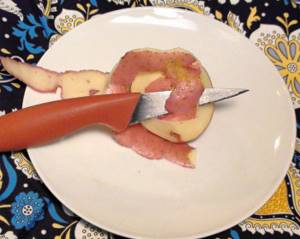
Meat dishes for those watching their figure
Almost all weight loss systems recommend not giving up meat products, but giving preference to white poultry meat. However, this does not mean that you need to give up on red, forever and ever giving up cutlets, cabbage rolls, kebab and even stewed potatoes with meat, which contain as much as 180 kcal per hundred grams. You just have to approach the issue of preparing it and combining it with other products wisely.
- First, of course, among the heat treatment methods, make a choice in favor of a double boiler, multicooker or oven. Try not to fry in a pan, or do it without adding oil. In addition to the fact that the “weight” of the dish and its fat content increase, a significant portion of the beneficial properties disappears in this way.
- Secondly, try not to overdo it with mayonnaise, sour cream or butter: it is better to marinate the meat in vinegar or lemon juice, which will allow it to remain juicy, but will not increase cholesterol levels and will not cause food to be deposited in problem areas.
- Thirdly, it is best to combine animal protein with vegetables. Of course, if the “heaviness”, difficulty of digestion and calorie content of potatoes and meat do not stop you, you can eat them together, but it is advisable to stew them, and also add ginger, garlic or at least pepper to stimulate digestion and make the dish easier to accept by the body. Variations with cucumbers, tomatoes, and zucchini are well received. It will work great in tandem with pumpkin or cabbage. You don’t have to worry about the calorie content of cabbage rolls with meat or stuffed peppers, since it will show no more than 214 and 180 kcal, respectively, and will vary depending on whether pork, beef, veal or lamb is used. But fears should be dispelled not so much by the numbers as by the nutritional value of the dish and the fact that most vegetables neutralize the severity of meat products, thereby preventing them from turning into excess weight.
